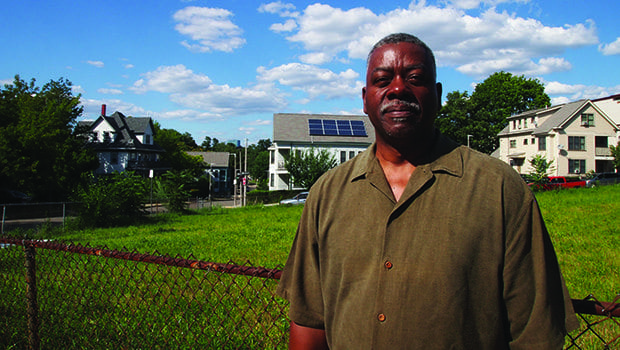
The city of Boston’s Department of Neighborhood Development and community members from Roxbury’s Garrison Trotter Neighborhood Association have forged a set of design principles to guide residential development on some city-owned vacant land parcels. As part of a new Neighborhood Homes Initiative, the DND plans to offer reduced land pricing and subsidy funding to spur the creation of home ownership opportunities affordable to a range of income levels.
“We are pushing the idea that some people still want houses as opposed to luxury apartments,” said GTNA President Louis Elisa. “They’re saying the Millennial generation doesn’t want houses with yards. But some people still like having a lawn party and having people over for Thanksgiving dinner.”
Elisa said GTNA has been working for 38 years to ensure that neighborhood parcels left empty after urban renewal projects decades ago are put to good uses that serve community residents. One of the key goals is affordable home ownership opportunities for moderate income people.
“[We] have forced and cajoled to make sure all those lots owned by the city were cleaned up. We’re not just a one-issue association, but we know that housing is the formal basis for determining how a community develops.”
Dan Richardson, past GTNA president and part of the association’s seven-member housing committee, echoed the emphasis on home ownership.
“The problem has always been whether you spend money to get people to have equity, or you spend it on deeper and deeper subsidies for rentals,” he observed. “If you’re looking at a full range of options for someone who wants to be in good housing, why isn’t equity housing an option as well? [But] most times, in communities of color, that’s not been an option.”
Richardson said “God knows” what might be built on the vacant land if local residents don’t stay closely involved in planning.
On the Web
Neighborhood Homes Initiative: http://dnd.cityofboston.gov/#page/NeighborhoodHomesInitiative
Garrison Trotter project details: http://courbanize.com/dnd-garrison-trotter-neigh borhood-homes-sites/
“Some developer from somewhere would say ‘Why don’t we build some high-rises, why don’t we build some rental units and set up a 40-year plan for making a lot of money?’” he conjectured.
Sheila Dillon, DND director and the city’s chief of housing, said her department has been meeting with GTNA since last July to discuss the types of houses that should go on some 20 vacant lots located mostly on Holworthy, Hollander, Waumbeck, Harold and Crawford Streets.
The planning is part of the city’s Neighborhood Homes Initiative, an effort to create more housing affordable to middle-income workers by selling city land at low prices and developing prototype designs that can be built at lower cost and will not likely demand a drawn-out approval and permitting process. The city will market the homes to moderate and middle-income buyers. Citywide, about two-thirds of this housing will be deed-restricted and affordable to middle-income families, Dillon said.
DND has been analyzing neighborhoods individually to make sure the designs they propose are “contextual” for each area.
“We’re having these really good dialogues around the city right now,” she said. “These aren’t one-offs. They’re very thoughtful plans.”
A slide presentation delivered by DND at a June 18 meeting with GTNA includes five prototype designs for single-family, two-family and side-by-side duplex homes with porches and gabled roofs. The houses are consistent in roofline and massing and set back a similar distance from the street.
The new standards define everything from the height of the first floor from ground level to the symmetry of window and door placement. The standards are not new zoning regulations, but recommendations, Dillon said, meant to help smaller developers keep costs down and get a head start on proposing home styles that will suit the neighborhood.
The next step will be a request for proposals (RFP), which the city is expected to issue this fall. Dillon emphasized that it is in draft stage now and will certainly be reviewed by GTNA before release.
Potential bidder
Arnold Johnson, president of Crosswinds Enterprises, said his firm will likely submit a bid when the RFP is issued.
“Home ownership in the community is something we value and the GTNA values it also,” said Johnson, whose company is located in the Garrison-Trotter area. “I think we do need homes people can afford. The price of construction has gone up so much, so to build a house without subsidy is really tough. Most of the people in our neighborhood can afford something around the 250,000 to 300,000 range and there’s nothing out there like that.”
Crosswinds has already built homes in the area. Its Garrison Trotter Homes at Crawford and Waumbeck Streets are seen by Richardson and Elisa as successful models of home quality and design. But the most recent time an RFP was issued for vacant parcels in the area, Crosswinds was approved and moving toward construction, Johnson said, until the economy soured.
“We were all permitted and the zoning was settled,” he said. “We had to pull back when the market dipped. [The Boston Redevelopment Authority] de-designated us because we didn’t move forward on it.”
Now Crosswinds will need to start over in the process and put in a new bid.
“I figured we’d just resume the project, but that didn’t happen. We had spent $200,000 to $300,000, and we’re a small local developer,” he said. “We have so much invested in it, so we will put in a bid to respond to [the new RFP].”
So far, GTNA appears to be cautiously satisfied with the process of hashing out the details with DND representatives.
“I don’t think it’s utopian, but if we’re really serious, we can get this done,” said Richardson. “We are developing standards for how we are going to move forward in this community. I hope we can get this done and make as many people happy with it as possible.”






